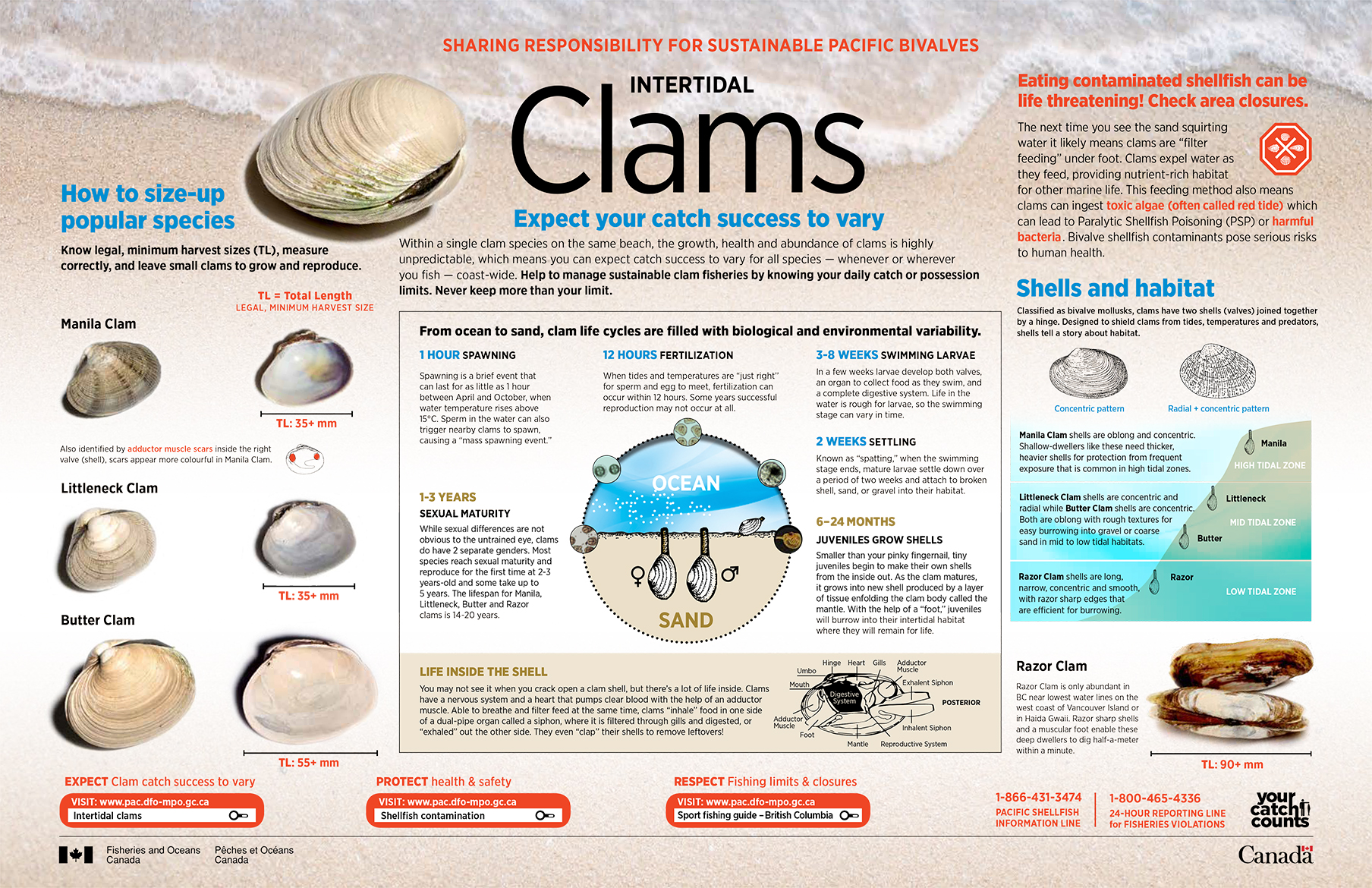Sharing responsibility for Pacific bivalves : Intertidal clams

Description: Sharing responsibility for Pacific bivalves-Intertidal clams
Eating contaminated shellfish can be life threatening!
Always check marine biotoxin and sanitary contamination closures for the area where you are harvesting. Closures change frequently throughout the year. It is illegal to harvest shellfish from closed or contaminated areas.
Sharing responsibility for Pacific bivalves: Intertidal clams
Classified as bivalves, clams are mollusks with two valves — two shells joined by a hinge.
Check area closures
The next time you see the sand squirting water it likely means clams are “filter feeding” under foot. Clams expel water as they feed, providing nutrient-rich habitat for other marine life. This feeding method also means clams can ingest toxic algae (often called red tide) which can lead to Paralytic Shellfish Poisoning (PSP) or harmful bacteria. Bivalve shellfish contaminants pose serious risks to human health.
Expect your catch success to vary
Within a single clam species on the same beach, the growth, health and abundance of clams is highly unpredictable, which means you can expect catch success to vary for all species — whenever or wherever you fish — coast-wide. Help to manage sustainable clam fisheries by knowing your daily catch or possession limits. Never keep more than your limit.
Clam life cycles are affected by what happens in the ocean
| Life stage | What happens at this stage |
|---|---|
| Spawning | Spawning is a brief event that can last for as little as 1 hour between April and October, when water temperature rises above 15°C. Sperm in the water can also trigger nearby clams to spawn, causing a “mass spawning event.” |
| Fertilization | When tides and temperatures are “just right” for sperm and egg to meet, fertilization can occur within 12 hours. Some years successful reproduction may not occur at all. |
| Swimming lavae | In a few weeks larvae develop both valves, an organ to collect food as they swim, and a complete digestive system. Life in the water is rough for larvae, so the swimming stage can vary in time. |
| Settling | Known as “spatting,” when the swimming stage ends, mature larvae settle down over a period of two weeks and attach to broken shell, sand, or gravel into their habitat. |
| Juveniles grow shells | Smaller than your pinky fingernail, tiny juveniles begin to make their own shells from the inside out. As the clam matures, it grows into new shell produced by a layer of tissue enfolding the clam body called the mantle. With the help of a “foot,” juveniles will burrow into their intertidal habitat where they will remain for life. |
| Sexual maturity | While sexual differences are not obvious to the untrained eye, clams do have 2 separate genders. Most species reach sexual maturity and reproduce for the first time at 2 to 3 years-old and some take up to 5 years. The lifespan for Manila, Littleneck, Butter and Razor clams is 14 to 20 years. |
Life inside the shell
You may not see it when you crack open a clam shell, but there’s a lot of life inside. Clams have a nervous system and a heart that pumps clear blood with the help of an adductor muscle. Able to breathe and filter feed at the same time, clams “inhale” food in one side of a dual-pipe organ called a siphon, where it is filtered through gills and digested, or “exhaled” out the other side. They even “clap” their shells to remove leftovers!
Diagram of the inside of a clam
- Posterior
- Exhalent siphon
- Inhalent siphon
- Reproductive System
- Mantle
- Foot
- Adductor muscle
- Mouth
- Umbo
- Hinge
- Heart
- Gills
- Adductor muscle
- Digestive system
How to size-up popular species
Know legal, minimum harvest sizes (TL = Total Length), measure correctly, and leave small clams to grow and reproduce.
| Clam type | Legal, Minimum harvest size |
|---|---|
| Manila clam Also identified by adductor muscle scars inside the right valve (shell), scars appear more colourful in Manila Clam. |
Total length=35+ mm |
| Littleneck clam | Total length=35+ mm |
| Butter clam | Total length=55+ mm |
Razor clam
Razor clam total length=90+ mm
Razor clam is only abundant in BC near lowest water lines on the west coast of Vancouver Island or in Haida Gwaii. Razor sharp shells and a muscular foot enable these deep dwellers to dig half-a-meter within a minute.
Shells and habitat
Designed to shield clams from tides, temperatures and predators, shells tell a story about habitat.
| Habitat | Clam shell description |
|---|---|
| High tidal zone | Manila Clam shells are oblong and concentric. Shallow-dwellers like these need thicker, heavier shells for protection from frequent exposure that is common in high tidal zones. |
| Mid tidal zone | Littleneck Clam shells are concentric and radial while Butter Clam shells are concentric. Both are oblong with rough textures for easy burrowing into gravel or coarse sand in mid to low tidal habitats. |
| Low tidal zone | Razor Clam shells are long, narrow, concentric and smooth, with razor sharp edges that are efficient for burrowing. |
Expect clam catch success to vary, protect health & safety, respect fishing limits & closures.
Pacific shellfish information line: 1-866-431-3474
24-hour reporting line for fisheries violations: 1-800-465-4336
Related materials
- Date modified: